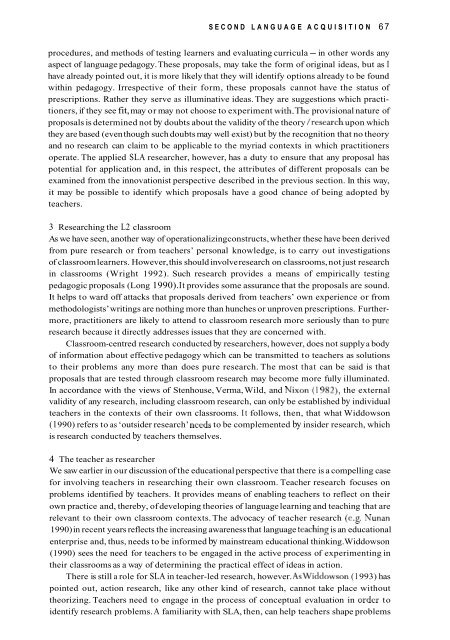English Language Teaching in its Social Context
English Language Teaching in its Social Context
English Language Teaching in its Social Context
Create successful ePaper yourself
Turn your PDF publications into a flip-book with our unique Google optimized e-Paper software.
SECOND LANGUAGE ACQUISITION 67procedures, and methods of test<strong>in</strong>g learners and evaluat<strong>in</strong>g curricula ~ <strong>in</strong> other words anyaspect of language pedagogy. These proposals, may take the form of orig<strong>in</strong>al ideas, but as Ihave already po<strong>in</strong>ted out, it is more likely that they will identify options already to be foundwith<strong>in</strong> pedagogy. Irrespective of their form, these proposals cannot have the status ofprescriptions. Rather they serve as illum<strong>in</strong>ative ideas. They are suggestions which practitioners,if they see fit, may or may not choose to experiment with.The provisional nature ofproposals is determ<strong>in</strong>ed not by doubts about the validity of the theory /research upon whichthey are based (even though such doubts may well exist) but by the recognition that no theoryand no research can claim to be applicable to the myriad contexts <strong>in</strong> which practitionersoperate. The applied SLA researcher, however, has a duty to ensure that any proposal haspotential for application and, <strong>in</strong> this respect, the attributes of different proposals can beexam<strong>in</strong>ed from the <strong>in</strong>novationist perspective described <strong>in</strong> the previous section. In this way,it may be possible to identify which proposals have a good chance of be<strong>in</strong>g adopted byteachers.3 Research<strong>in</strong>g the L2 classroomAs we have seen, another way of operationaliz<strong>in</strong>g constructs, whether these have been derivedfrom pure research or from teachers’ personal knowledge, is to carry out <strong>in</strong>vestigationsof classroom learners. However, this should <strong>in</strong>volve research on classrooms, not just research<strong>in</strong> classrooms (Wright 1992). Such research provides a means of empirically test<strong>in</strong>gpedagogic proposals (Long 1990). It provides some assurance that the proposals are sound.It helps to ward off attacks that proposals derived from teachers’ own experience or frommethodologists’ writ<strong>in</strong>gs are noth<strong>in</strong>g more than hunches or unproven prescriptions. Furthermore,practitioners are likely to attend to classroom research more seriously than to pureresearch because it directly addresses issues that they are concerned with.Classroom-centred research conducted by researchers, however, does not supply a bodyof <strong>in</strong>formation about effective pedagogy which can be transmitted to teachers as solutionsto their problems any more than does pure research. The most that can be said is thatproposals that are tested through classroom research may become more fully illum<strong>in</strong>ated.In accordance with the views of Stenhouse, Verma, Wild, and Nixon (1 982), the externalvalidity of any research, <strong>in</strong>clud<strong>in</strong>g classroom research, can only be established by <strong>in</strong>dividualteachers <strong>in</strong> the contexts of their own classrooms. It follows, then, that what Widdowson(1 990) refers to as ‘outsider research’ needs to be complemented by <strong>in</strong>sider research, whichis research conducted by teachers themselves.4 The teacher as researcherWe saw earlier <strong>in</strong> our discussion of the educational perspective that there is a compell<strong>in</strong>g casefor <strong>in</strong>volv<strong>in</strong>g teachers <strong>in</strong> research<strong>in</strong>g their own classroom. Teacher research focuses onproblems identified by teachers. It provides means of enabl<strong>in</strong>g teachers to reflect on theirown practice and, thereby, of develop<strong>in</strong>g theories of language learn<strong>in</strong>g and teach<strong>in</strong>g that arerelevant to their own classroom contexts. The advocacy of teacher research (e.g. Nunan1990) <strong>in</strong> recent years reflects the <strong>in</strong>creas<strong>in</strong>g awareness that language teachmg is an educationalenterprise and, thus, needs to be <strong>in</strong>formed by ma<strong>in</strong>stream educational th<strong>in</strong>k<strong>in</strong>g. Widdowson(1 990) sees the need for teachers to be engaged <strong>in</strong> the active process of experiment<strong>in</strong>g <strong>in</strong>their classrooms as a way of determ<strong>in</strong><strong>in</strong>g the practical effect of ideas <strong>in</strong> action.There is still a role for SLA <strong>in</strong> teacher-led research, however. AsWiddowson (1 993) haspo<strong>in</strong>ted out, action research, like any other k<strong>in</strong>d of research, cannot take place withouttheoriz<strong>in</strong>g. Teachers need to engage <strong>in</strong> the process of conceptual evaluation <strong>in</strong> order toidentify research problems. A familiarity with SLA, then, can help teachers shape problems












